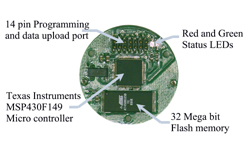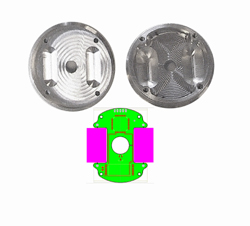Development of a Miniature Data Logger for Collecting Outcome Measures for Wheeled Mobility
ABSTRACT
The human Engineering Research Laboratories (HERL) has developed a new, low-power, self-contained, data logger for wheelchair research. The enclosure is about the size of a 35 mm film canister and 1/10 the weight and volume of a prior model developed by HERL in 2000. It has been prototyped and bench tested. Hardware and electronics are being refined. Concurrently under development is a caster data logger that will use the same electronics sealed inside a caster hub.
KEYWORDS
Outcome measures, wheeled mobility, data logging
BACKGROUND
Reliable quantification of benefits derived from assistive technology can improve practice credibility and encourage insurance reimbursement. Data gathered by recording devices provide more objective measures than patient self-reports. Battery powered data loggers are routinely used in industry but their use with rehabilitation technology is limited due to factors such as limited battery life, low data capacity and setup complexity. In 2000, the Human Engineering Laboratories (HERL) developed a first generation data logger [1] . This design used the TFX-11 microcontroller board supplied by Onset computer corporation, Bourne, MA. This system provided data for a study conducted by Cooper et al. [2] which documented the daily mobility habits of wheelchair operators. This first design had several significant limitations. 1) The enclosure (152 X 100 X 50 mm) weighed about 2 pounds and had to be mounted on the wheelchair frame; 2) a separate motion “pick-up” sensor had to be mounted near the wheel and wiring run back to the enclosure; and 3) battery life was limited to two weeks. These factors made for a labor-intensive setup and discouraged some manual wheelchair users from serving as test subjects due to the weight and bulk.
DESIGN APPROACH
In February 2003, HERL began development of a new miniature data logger (MDL). We sought to overcome the limitations of our 2000 hardware through several key design changes. 1) A small, non-obtrusive but weather tight enclosure 2) Fasteners simple enough so that MDL could be mailed to a test subject and installed locally; 3) Extended time data collection periods and higher data storage capacity; and, 4) Inexpensive enough to consider volume manufacturing for studies of large populations (N>100).
 |
|---|
Figure 1 shows the prototype. This self-contained module mounts easily on most wheelchairs through a simple clip on the rear of the enclosure. Placing the MDL between the wheel spokes protects it from impact and keeps it from interfering with propulsion.
Integrated motion sensor To eliminate the need for an external motion detector, we developed a pendulum that pivots within the enclosure behind the PC board. A 3 mm diameter rare earth Neodymium-Iron-Boron magnet occupies one end of this pendulum and maintains a “6 o'clock” position due to gravity. Whenever the chair wheel and enclosure rotate, the magnet sweeps in a circle over six sensors mounted at 60 degree intervals on the back of the printed circuit (PC) board. The current design employs three digital Hall effect transistors and three ultra miniature reed switches.
 |
|---|
Embedded system features The Hall effect and reed switches trigger digital input pins on an ultra low-power microcontroller (Texas Instruments, MSP430F149). This microcontroller only draws a few microamperes when in sleep mode. It contains 60 KB of flash and 2 KB of RAM memory eliminating the need for additional chips to hold the program and variables. It maintains a real-time clock and “time stamps” each sensor event with one-tenth second resolution. The data are compressed and stored on a 32-megabit serial “flash” memory chip (Atmel AT45DB321B), which retains data even if there is a battery failure. A Delran cap (not shown) fits tightly over the front of the aluminum enclosure and uses a neoprene O-ring for a weather tight seal. Two tiny light emitting diodes (LED) on the front of the PC board flash periodically to provide status information; a 6 mm diameter Lucite ä window in the Delran cap permits these LED's to be viewed. A 2/3 AA lithium battery (not shown) powers the MDL and fits above the PC board. Based on the manufacturers' data sheets, our MDL should operate up to a year without battery replacement and record up to 750 miles of wheelchair activity.
 |
|---|
Software We developed our own operating software for the MDL using an IAR (IAR Systems, Foster City, CA) development package with a C language cross-compiler and JTAG (Joint Test Action Group) interface. An SRAM buffer captures incoming data until a full flash page (528 bytes) accumulates; then, the bytes transfer as a block to the Atmel serial flash memory. A miniature 14 pin, two mm pitch header on the PC board supports both software updates and data downloading. An RS232 protocol transfers data to any PC computer. To error check and decompress the data, we developed a MATLAB (The Mathworks, Inc, Natick, MA) program. The output of the MATLAB program is a file suitable for importation into SAS (SAS Institute Inc., Cary, NC) or SPSS (SPSS, Inc., Chicago, IL) for statistical analysis.
Caster Data Logger Closely related to the miniature, data logger project is our concurrent development of a caster data logger (CDL). On the CDL, the PC board is sandwiched between two, 6061-T6 aluminum flanges machined on our computer numerically controlled (CNC) lathe and mill. We contour the circumference of the hub to match commercially made polyurethane tires. The prototype illustrated in Figure 4 is the hub for a 4” caster.
 |
|---|
With minor alterations to our computer aided design (CAD) and computer aided manufacturing (CAM) software, 6” and 8” casters will be produced with the same chamber pockets and PC board. The PC board is specially shaped to fit within the confines imposed by axle bearings and bolt pattern but will incorporate most of the circuit successfully developed on MDL. Upgrades include two lithium batteries to extend the data collection time and a larger flash memory chip (128 mega bits) that has recently become available. Instead of a pendulum, the activation magnet will mount in an aluminum ring keyed to the axle. The magnet will trigger a single reed switch on the PC board with each caster revolution. In order to download data to a personal computer or laptop, an investigator or technician will need to disassemble the caster hub, extract the PC board and use a card edge connector to export the data to a PC.
CURRENT STATUS/DISCUSSION
We have completed the construction of fifteen MDL units. Several of our lab members have worn them on their personal wheelchairs for up to two weeks. We discovered during field tests that the gravity pendulums occasionally “stick” and rotate with the PC board at higher chair velocities and cambers. We are replacing the aluminum pendulums with heavier ones made from brass and incorporating a miniature ball bearing in the pivot. Battery “manual insert ”connectors have proved vulnerable to centrifugal forces and we have taken to soldering the battery directly to the PC board for increased reliability. After comparing the performance of Hall effects and reed switches, we chose to use the reed switches exclusively. The power, duty cycling necessary to obtain the low-power characteristics of the Halls, caused them to miss events at higher chair velocities. The ultra miniature reed switches have a response time of about a mille second and consume no power at all. Since only micro amps of current are required to trigger the microcontroller pins, the reed contacts should not wear out prematurely.
The low power microcontroller and high capacity flash memory technologies developed for the digital camera industries are inexpensive and well suited for this application. We used popular CAD and CAM software to create the prototypes, which will simplify commercialization. When specifying larger quantities for future studies, we will examine casting as well as machining for the metal components. The PC boards will be machine populated, reflow soldered and potted to make them further resistant to environmental exposure.
REFERENCES
- Spaeth DM, Arva J, and Cooper RA, "Application of a commercial data logger for rehabilitation research" 2000.
- Cooper RA et al, "Driving characteristics of electric powered wheelchairs: how far, fast and often do people drive?," Archives of Physical Medicine and Rehabilitation , vol. 83, no. 2, 2002.
ACKNOWLEDGEMENTS
This research was funded by the Rehabilitation Engineering Research Center (RERC) on Wheeled Mobility #H133E990001 through the U.S. Department of Education, National Institute on Disability and Rehabilitation Research (NIDRR).
Author Contact Information:
Donald M. Spaeth, PhD,
Human Engineering Research Laboratories (151R1),
VA
Pittsburgh Healthcare System,
7180 Highland Dr.,
Pittsburgh PA 15206,
(412)
365-4850,
spaeth@pitt.edu
